Porto Esação de São Bento Railway Station
The Sao Bento Railway Station can be found on the Avenue Dom Afonso Henriques. It is one of the top 10 places to see in Porto. The exterior is attractive but it is the blue and white tiled decorated interior that is impressive.
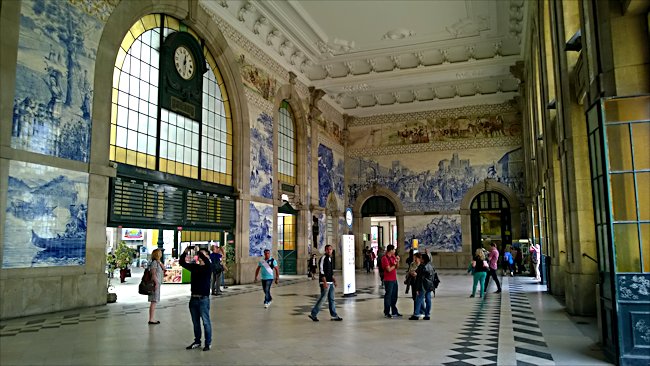
The Saint Bento Railway Station in Porto is decorated with blue and white tiles that depict historical scenes
The exterior of the railway station looks like a French chateau. Construction began in 1900. Porto needed a new main railway station that would link it with Lisbon. It was part of the master plan for Portuguese railway expansion that included the construction of the new wrought iron bridges that crossed the river Douro.
The Sao Bento train station was built on the site of an old Benedictine monastery. This religious building was built during the 1500s and called Sao bento de Ave Maria. Records show the original building was burnt down in 1783. It was replaced by a new stone built monastery but through lack of funding it started to crumble by the late 1800s it was in a very bad state of disrepair.
A local architect, Jose Marques da Silva won the contract to build the new railway station on the site of the monastery. The committee who awarded him the job liked his French Beaux-Arts style plans. The first stone was laid by King Carlos I of Portugal as an expression of his support for this modernisation project that would hope to bring additional prosperity to the region.
It took over 16 years to complete the building. It was a very large project. It is now one of the landmarks of the city of Porto. Most visitors come to see the highly decorated vestibule. The architect commissioned the famous Portuguese artist Jorge Colace to paint very large polychrome blue-and-white paintings of historical Portuguese events and then transfer them to tiles.
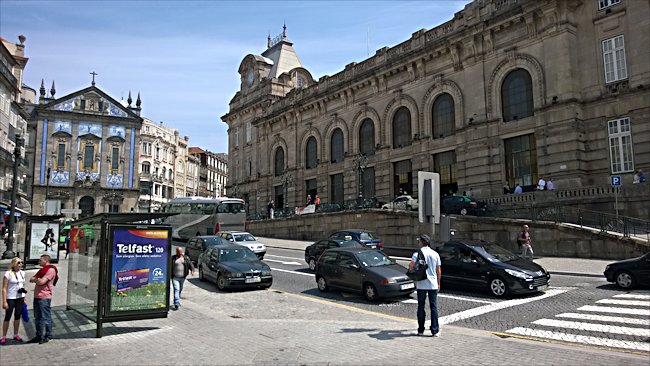
Porto Esação de São Bento Railway Station exterior
The use of blue and white "Azulejos" tiles to decorate the interior and exteriors of public and private buildings in Porto has been popular since the invasion of Spain and Portugal by the Moors of North Africa in the 711 A.D. When the armies of the Moors were driven out by the Christian kings many of the craftsmen stay behind and continued to make tiles. The style changed from using coloured tiles to make concentric patterns, to tiles that showed pictures.
Over 20,000 "Azulejos" tiles have been used to decorate the interior of Esação de São Bento Railway Station in Porto. They were laid between 1905 in 1916. The major benefit of using tiles on walls rather than painting them is that they do not need repainting every 5 years. They are also cool to the touch and help to keep the temperature down on hot summers days in the railway station ticket hall.
Many of the tiled paintings show historical events. The painting below shows Philippa of Lancaster, daughter of John Gaunt the English 1st Duke of Lancaster, being met by her future husband King (Joao) John I of Portugal in 1387 and paraded through the streets prior to the grand wedding ceremony in Porto's Cathedral. This wedding was the start of one of the world's longest political relationships. England and Portugal have always been allies from this point onwards.
They had a famous son, called Prince (Enrique) Henry the Navigator. He was one of them instrumental figures in establishing the Portuguese Navy as a global dominant power that explored unknown areas of the world and claim them for the Portuguese empire.
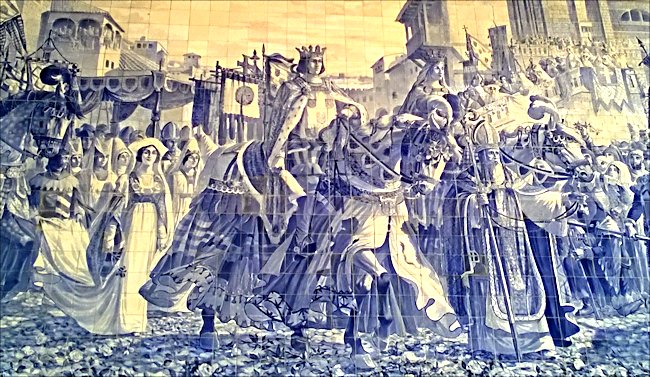
This blue and white tiled painting in the railway station shows the arrival of Philippa of Lancaster accompanied by her future husband King John I of Portugal.
Another tile painting shows the adventures of the real-life Prince Henry the Navigator. He was known as the Infante Dom Henrique de Avis, Duke of Viseu and was the 3rd son of King John I of Portugal. He never became King but he was very active in the affairs of the Portuguese state. When he was 21 he went on a military expedition, with his father and brothers, to attack the Barbary pirates base of operations in Morocco.
They had been attacking Portuguese merchant ships to steal their cargo and fishing villages to capture the inhabitants to become slaves. The raid was centred on the port of Ceuta in northern Morocco. The Portuguese were successful and the painting in the railway station shows the Arabian Barbary Moor's surrendering to Henry the Navigator.
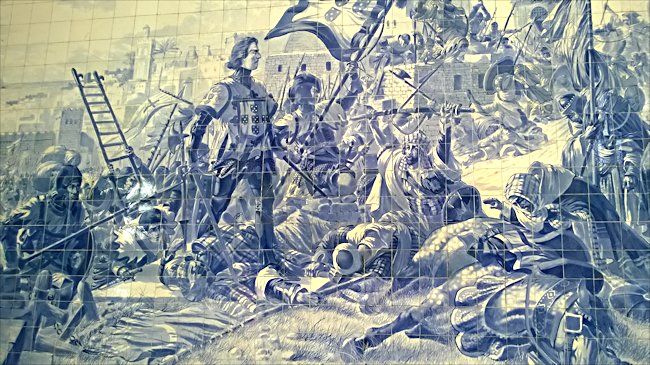
This tiled wall picture shows Prince Henry the Navigator conquering Ceuta in Morocco
This tiled painting below shows the King of Spain King Alfonso VII with the Portuguese Crusader Knight Egas Moniz and his family presenting themselves as penitents, barefoot with ropes around their necks, falling on the mercy of the king. This event took place in Toledo and represents the principle of "Honour above all even at the cost of freedom and life".
At this time in history the North African Moors had occupied most of Spain and what was to become Portugal for over 300 years. The Christian fightback to push the moors out of the Iberian Peninsula was being led by King Alfonso VII of Leon who had declared himself king of all Spain, Portugal at that time was just known as the County of Portucale and part of the new Spain.
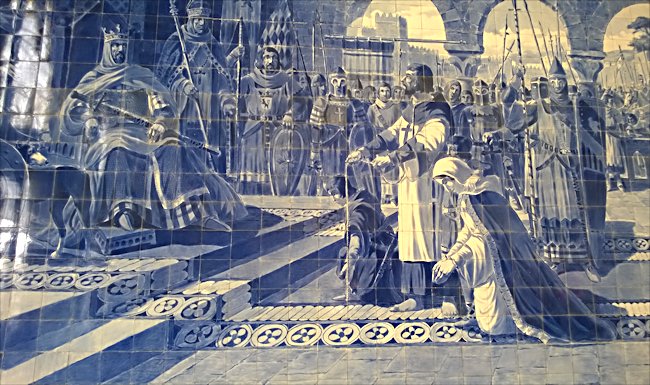
This tiled wall picture shows the meeting of King Alfonso VII and the Crusader Knight Egas Moniz.
Egas Moniz de Ribadouro was the richest man in the County of Portucale. The Count of Portucale, the Duke of Burgundy entrusted the education of his son Dom Afonso Henriques to Egas Moniz. When Afonso Henriques came of age he battled for the independence of Portugal.
King Alfonso VII, King of Spain was not happy with the situation and laid siege to the capital of the county of Portucale, Guimaraes, native city of Dom Afonso Henriques. Egas Moniz was sent to the King of Spain to represent him where it was agreed that Dom Afonso Henriques, and Portugal would be a vassal of the King of Spain.
This peace did not last long. Afonso Henriques went back on his word. He declared Portugal an independent country. He won a battle against the Spanish at Cerneia in 1137. Having given his word to the Spanish King, Egas Moniz felt that the only honourable thing he could do was offer himself and his family up to the justice of King Alfonso VII. The king was so moved by his great display of honour but he sent him back to Portugal without taking any action against him.
Travel Books

